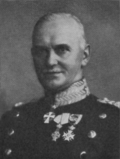| Chief of the General Command | |
|---|---|
| Chefen for Generalkommandoen (Danish) | |
 Flag for the Chief of the General Command | |
| Style | His Excellency |
| Residence | Commander's House, Kastellet |
| Precursor | 1st General Command 2nd General Command |
| Formation | 7 August 1922 |
| First holder | Ellis Wolff |
| Final holder | Ebbe Gørtz |
| Abolished | 30 September 1950 |
| Succession | Chief of the Army Command |
| Deputy | Chief of the General Staff |
The General Command (Danish : Generalkommandoen) was the highest command body in the Royal Danish Army. It was erected in 1922 Defence Agreement, adopted by Rigsdagen on 7 August 1922 and was a result of collecting 1st and 2nd General Command. [1] It was terminated in 1950, following the Danish defense reform of 1950, which split it into Eastern and Western Regional Command.





